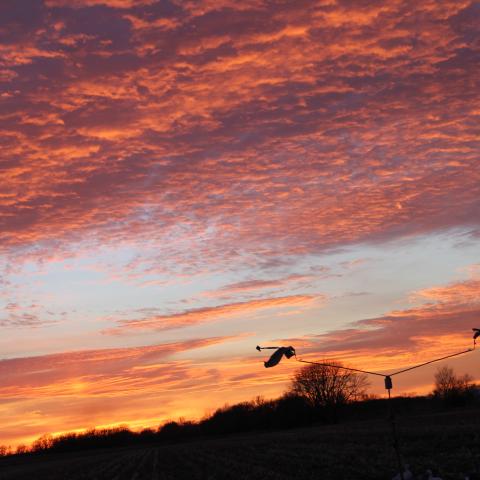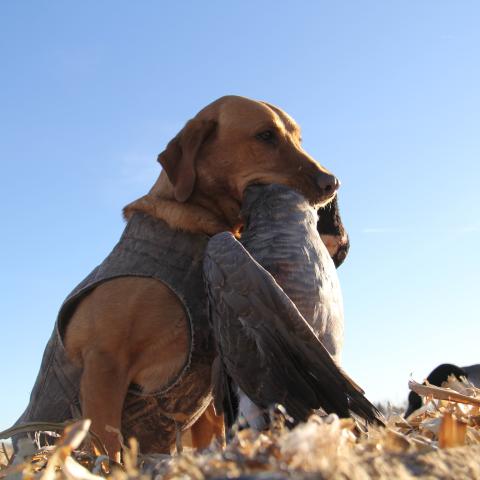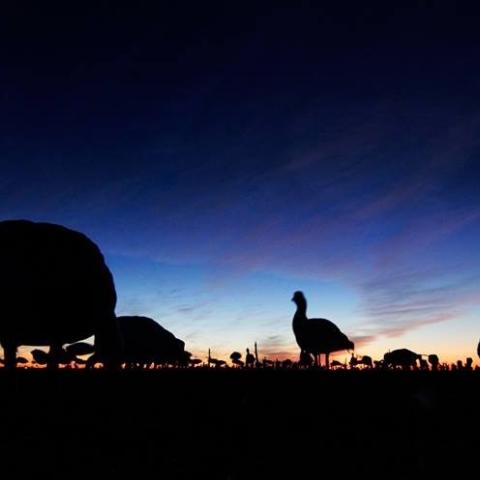Rise and Grind
To enjoy early season waterfowl magic, hunt where the birds are, don’t sweat the weather, have a sense of humor and stay optimistic
The young man leading us afield made a few mistakes before we even left the truck. First, he mentioned that he'd gotten the gig because he was a hockey player friend of the outfitter's son.
"Then you grew up here in hunting paradise," I offered from the back seat. "You must've chased birds like crazy here your whole life?"
I couldn't imagine doing otherwise growing up in the Great Duck Factory.
"Nope. Honestly, I've never even fired a shotgun."
There was sudden quiet in the truck as that set in. It's hard to believe here in central Saskatchewan. Everyone was silent, processing this unfortunate information. No, he confirmed, he was not just driving us there to meet the guide; he was the guide. As we drove through the pre-dawn darkness, he stared at his phone, and I prayed he was not texting his friends but navigating to what would need to be the world's best X for us to do much good with such a green leader in a strange land.
Ultimately, this neophyte who needed to learn more would teach these veteran waterfowlers much about early-season hunting on a most amusing and wildly successful trip to Saskatchewan.
Rule number one? Go where the birds are, and things will fall into place. Ducks and geese are relatively easy to get into shotgun range this time of year, especially the further north you go. They have not seen all our tricks and are vulnerable to our setups. Scouting—and getting there first—trumps skills, tactics, and decoy strategies.
The second is to expect the unexpected. Third? Keep the faith! That's where I blew it on that Saskatchewan hunt and was gleefully corrected by fate.
We soon set up with snow goose decoys (too early for white geese, I was sure) on the side of a hill in tilled corn. I was not only unsure of using snow goose decoys so early (September), but also, I was not too fond of this side hill decoy spread business. Geese rarely land on hillsides, preferring to land on the top or bottom and walk up or down. Typically.
Next, our teen guide, who had never shot a gun, gave us our gun safety lecture, his wispy mustache barely visible, then explained what to do when he called the shot.
Wait! We can't have him calling the shots, I thought frantically. I didn't want that to happen due to his lack of experience. Shot-calling can make or break a hunt unless the birds are suicidal.
Think, man, think, how do I do this diplomatically, not hurt this kid's ego…
"Hey Jack…"
"It's John," he said.
"Sorry, uh, John," I continued, "but I was wondering if we could let ol' Bob here call the shots." I pointed to the old-timer in our group and continued, "It would mean a lot to him. He's hunted waterfowl forever, and he's got a bad back (true), and it will help him out a lot if he can call the shot and make the most of his shooting opportunities," I said in a voice so pleading it implied it was, <sniffle> possibly the old man's final hunt. I was trying to help us all out, not just the old man.
I watched the kid's face, and he grinned happily in relief.
"No problem, that's great!" he said and put his headphones back on. He hadn't even analyzed whether it was a vote of no confidence or not. Right then, for a guy leading a hunting trip who'd never shot a gun, I started to like him a little.
Old man Bob, who had organized the trip, gave me a knowing wink as we had dodged a bullet so the ducks and geese wouldn't be dodging all of ours.
Turns out, I didn't know as much as I thought I did. The outfitter had it together, and while he'd sent us with a newby, we hit prime locations that would trump grizzled veteran guides. Yes, they'd sent us with a greenhorn, but they'd laid out a plan so perfect he didn't need to be an experienced killer to lead us to bird nirvana.
As legal light approached, geese started at the bottom of that hill, pedaled slowly uphill, unlike any snow geese I'd seen, and came right into the weird hillside spread, where, to my eye, the dekes were too clumped together. Yet the birds were finishing perfectly into the wind at 15 yards when old man Bob would call the shot. The shot-calling by the old man started out crisp, sharp, military commander style. It confirmed all the efforts I had made to put him in charge. Then it started to get weird. But more on that later.
Mallards, pintails, and other ducks turned into the mix frequently (no better early-season duck spread than a bunch of goose decoys!) and added to the growing piles of birds. There were so many ducks that we had to admonish guys from shooting them so they didn't scare much larger approaching flocks of waterfowl away.
I vividly remember making one of my craziest shots. I was pinned down on my knees out in the decoy spread, picking up birds when some snow geese piled in. I held dead still, trying not to spook them, until the men in the layout blinds opened fire. That's when I looked up, locked on two fleeing geese, and rolled from my knees to my back. Muzzle skyward, I blasted one last-second that almost hit me while the guys roared with yells.
It was unforgettable hunting, and the next few days unfolded the same as we pulled trafficking ducks and geese from flight lines into hillside spreads, often from great distances. Lines of birds would creep along the distant treelines in small black clouds, slowly work their way towards us over five or ten minutes, and end up at 20 yards. It was always over too soon.
Everything I thought we were doing wrong proved to be no big deal in the end. That's the beauty of the early season. You have to have faith.
We could talk a lot about early season strategies, such as focusing on smaller groups of decoys, using all-dark decoys because the birds aren't plumed out yet, shotgun chokes and loads, using motion in the spread, and so on. But honestly, here's what you need to know. Use a fairly open choke, high-density loads (smaller shot sizes), and a reliable, well-cleaned, and proven shotgun, the best you can afford. Preferably a Super Black Eagle 3 in 12 gauge (if you will mostly be firing steel loads) or the lovely SBE3 20 gauge (if you have the budget for some non-toxic alternatives like tungsten and bismuth and blends of either).
But most of all, bring an open mind.
The truth is to have fun in the early season, go hunting, and try to go where the birds are. I've been surprised at the early-season duck hunts I have encountered in the upper Midwest, north Kansas, and the Dakotas because of early winter storms. Pray for a bit of wind because that always makes things better, but beyond that, pack up your trusty Benelli and get out there.
Early season hunt success is dictated mainly by being where birds try to get. You are good to go if you live near an area where ducks breed. If not, you must get there or pray for an early cold front to the north to move them toward you. It can happen with shocking speed. In Kansas, Canada, and the Dakotas, it will frequently go from t-shirt weather to snowing in 12 hours from September to October.
Further south in Mississippi, a slight drop in the temps into the seventies can bring a wave of teal overnight or take them away.
And remember, early season is a relative term. Mid-October is the late season in Canada, while November is the real kick-off for ducks in Colorado, where I live, and later still for geese.
Another seeming worst-case scenario hunt turned into a home run in South Dakota one year when the weather turned overnight from late summer temps to sheet ice on the water. We roasted the ducks despite the odds, and the outfitter, who I later learned was a pheasant operation specialist, told our group organizer, "Sure, we can get you on some ducks."
It started in the parking lot. This time, the neophyte guide was an old timer who looked constantly rattled but had that sympathetic air of someone who had been picked last, not just at P.E. as a kid but probably everything. This definitely was not his day job.
When was I just certain we were hosed? While his giant gorilla Lab stomped all over me in the truck, I asked, "Is this dog steady?" How would we get ducks in range with a dog that had clearly gotten into someone's Mountain Dew?
"Oh yeah!" bellowed the guide. "Steady as a rock! Say, any of you fellas got a duck call? Yeah? Good, good…anybody know how to blow one?"
But the weather was perfect, and we sneaked onto a grassy point to try and hide (no blind, of course). The only thing that stuck out to the birds was that giant roving black dog. I politely asked our guide to leash his canine, and at the first shots, we were soon treated to the sight of his giant gorilla Lab dragging him clear into the freezing water…anytime anybody raised a gun. Funny, but a dangerous situation, indeed, for the dog and the old timer, who now stared in fear at his pooch.
Our other group nearby shot off volleys at ducks, and I volunteered, "Hey man, I bet they have some birds they need that dog to help find!"
Luckily, he gathered up the massive canine and headed that way, leaving me and my friend to a most heavenly morning of dumping birds over skim ice in a howling wind, birds so eager to get out of the freezing wind they were duped by my mediocre calling and a handful of ugly decoys tossed on the ice. We got incredible fowl-weather photos, heavy straps, and a big smile on the whole day.
Traveling to spots with the most ducks like that is a treat. But it's just as wonderful when you don't travel much.
One of my most humorous episodes ever involved an early hunt at home in Colorado. A sunny day left us duckless on the sprawling reservoir, and it was so slow we let one of the kids take a coot. Next, our boat drifted away, and after somehow running to the other side of the lake to resecure it, we finally limped back to port in the dark after repairing the old outboard…twice. In bucking waves, we were saved by another old-timer in our party who knew motors.
We still talk and joke about all that and all the hundreds of ducks that flew just out of range. And that kid's coot, which he insisted on eating.
If all had gone well and we'd run out and shot quick limits, we probably wouldn't even remember it.
As for the old man on that original Saskatchewan sojourn, his shot calling turned out beautifully. Especially for himself.
He betrayed my vote to make him pit boss by taking advantage of his bad back condition. He would call the shot, "OKAY, KILL THEM!" and his gun would go off long before we could sit up from our layouts, like an exclamation point at the end of his command. "Take-them-BOOM!"
So, next round, I peeked over, and sure enough, he was slowly sitting up, so slow the birds mostly didn't flare, taking careful aim at the easiest bird and calling the shot with a BOOM.
"What the hell, Bob! I make you our shot-caller, and you thank me by sitting up and shooting before all of us?!"
"Hey, you were right, but with my bad back, I could never sit up fast enough to get a shot off," he shouted defensively. "I have to do it, or I'll never get to shoot."
Well, what can you say to that?
"Besides," he moaned, laying back down in his blind, allowing a poignant pause to make sure all were listening before saying loudly, pitifully: "You never know when it will be my last hunt. This could be it."
You can't say anything to that, either, right? I vowed to do the same thing someday and plan to blame my back. Sooner than later. Still, it didn't stop me from unloading his gun once when he wasn't looking.
"TAKE THEM—CLICK!"
What a sweet sound.





